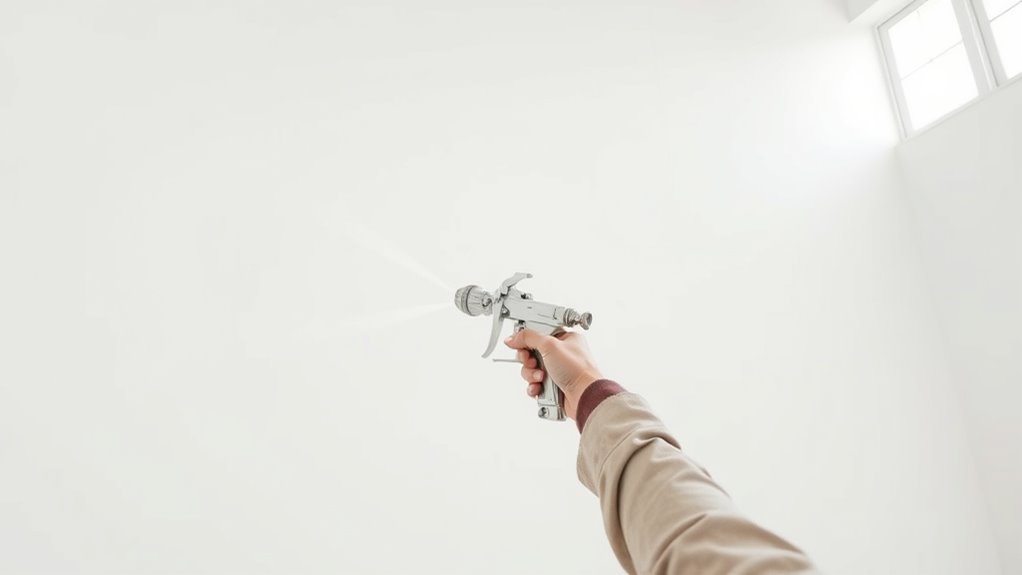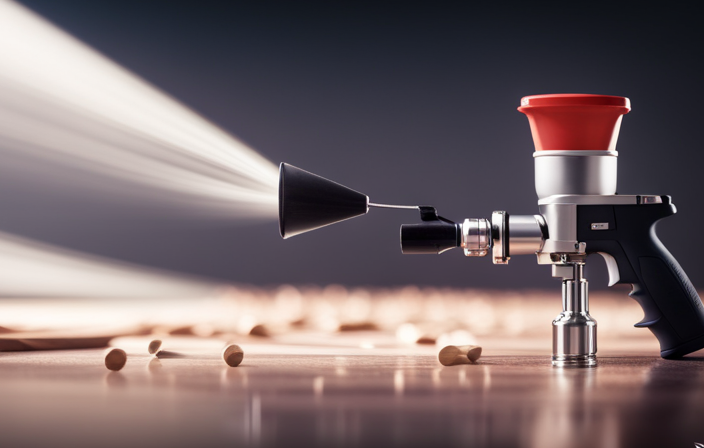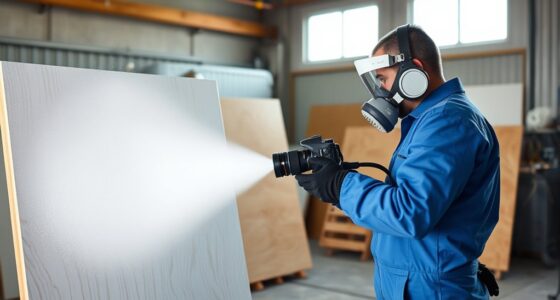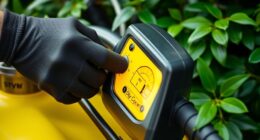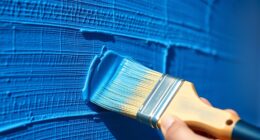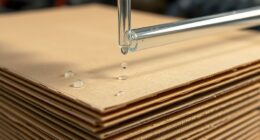To avoid lap marks on large walls, keep a steady spray technique by maintaining consistent distance and speed, usually about 10-12 inches from the surface. Work in overlapping passes, about 50%, to blend each section seamlessly. Use a wet edge to prevent dry lines, re-wetting areas as needed. Adjust your spray pattern and pressure for smooth application. Mastering these steps will help you get a flawless finish, and there’s more to learn for perfect results.
Key Takeaways
- Maintain a consistent spray distance (10-12 inches) and speed to ensure even coverage and prevent dry edges.
- Use overlapping passes, approximately 50%, to blend wet edges and eliminate visible lap lines.
- Keep the spray gun moving steadily without pausing at edges to avoid drying and lap marks.
- Adjust spray pattern and pressure for a uniform, continuous flow that reduces streaks and dry lines.
- Work in manageable sections, rewet edges regularly, and blend each pass seamlessly for a smooth finish.
Prepare Your Surface and Equipment
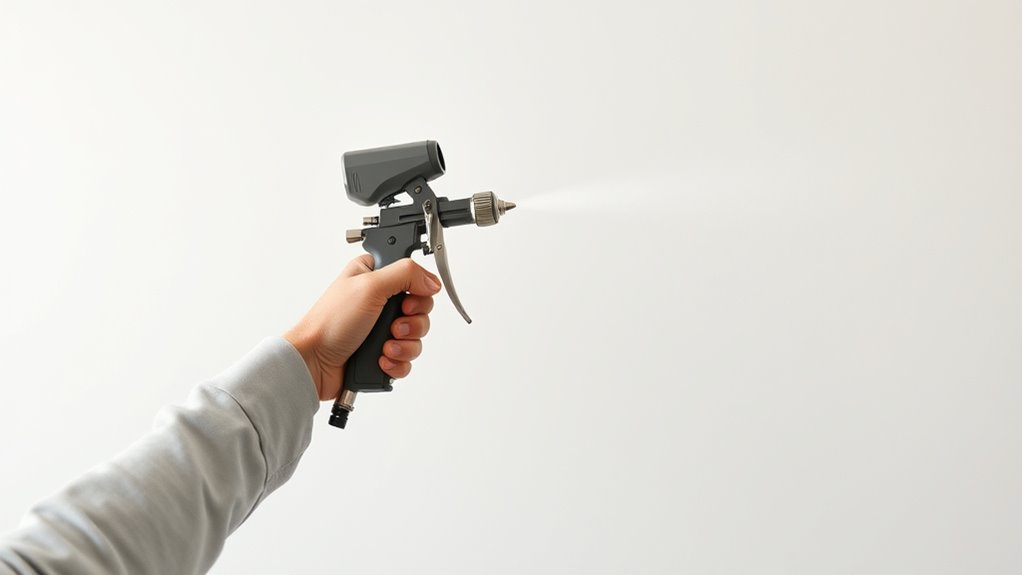
Before you start spraying, make sure your surface is clean, dry, and smooth. Surface cleaning is essential to remove dust, grease, or old paint that could cause uneven coverage or lap marks. Use a quality primer if needed to create a uniform base. Equally important is equipment calibration; check your spray gun’s settings to ensure consistent paint flow and spray pattern. Proper calibration prevents uneven layers and helps maintain a steady application. Inspect your tools for clogs or damage, and clean them thoroughly before use. Taking these steps guarantees the surface is ready to accept the paint and that your equipment delivers a smooth, even spray. Additionally, understanding the benefits of airless paint sprayers can help you select the right equipment and achieve a professional finish. Properly maintaining your tools and understanding pressure settings can further enhance the quality of your application. Being aware of spray technique can also contribute to avoiding lap marks and achieving a flawless coat. Paying attention to paint flow rate ensures consistent coverage and reduces the risk of visible lap lines. Preparing your surface and calibrating your equipment sets the foundation for a flawless finish.
Choose the Right Spray Technique
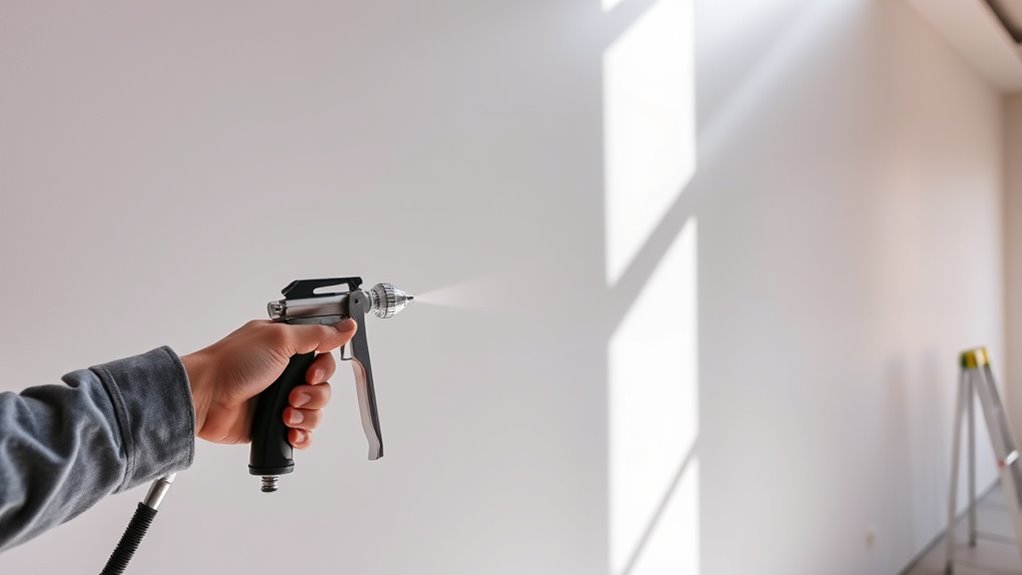
To prevent lap marks, you need to keep a consistent distance from the wall while spraying. Overlapping each stroke guarantees even coverage and smooth progression. Focus on maintaining these techniques for a flawless finish. Additionally, using high-quality spray equipment can help distribute paint evenly and reduce the risk of uneven layers. Being aware of proper support hours can ensure you have assistance available if you encounter any equipment issues during your project. Incorporating Volkswagen tuning concepts into your understanding of painting techniques can also help you achieve better control and precision during the process.
Maintain Consistent Distance
Are you maintaining a steady distance from the wall while spraying? Keeping a consistent distance helps prevent lap marks and ensures an even coat. To do this effectively:
- Maintain about 12-16 inches from the surface, adjusting based on spray tip and paint type.
- Use smooth, overlapping motions to avoid uneven coverage.
- Incorporate proper brush techniques for corners and edges to complement spraying.
- Ensure your paint is well mixed; inconsistent paint can cause drips or thin spots, disrupting your steady flow.
- Remember that spray technique is crucial for achieving a professional-looking finish and avoiding common pitfalls like lap marks. Practicing proper tuning techniques can also improve your spraying results by providing better control over the spray pattern and consistency.
- Additionally, understanding how sound vibrations influence cellular processes can inspire you to develop more precise spraying methods for better results. Staying at the right distance also reduces overspray and helps you control the spray pattern. Properly adjusting your equipment for optimal pressure control enhances spray quality and consistency. Incorporating automation in manufacturing principles into your spraying process can further improve efficiency and uniformity. Remember, a consistent spray distance combined with proper paint mixing creates a smooth, professional finish without lap marks.
Use Overlapping Strokes
Using overlapping strokes is essential to achieving an even, professional finish when spraying large walls. To do this effectively, focus on your brush techniques and maintain consistent paint consistency. Keep your spray gun at a steady distance and move smoothly across the surface, ensuring each pass overlaps the previous by about 50%. This overlap helps blend the paint seamlessly, preventing lap marks and uneven patches. Adjust your spray pattern and speed to match the paint’s flow, avoiding drips or thin spots. Proper brush techniques, like feathering the edges, also contribute to a uniform look. Consistent paint consistency ensures the spray flows smoothly, reducing spray pattern fluctuations. Incorporating biodiversity-friendly practices such as choosing eco-friendly paints can further enhance the sustainability of your project. Additionally, understanding the paint flow properties can help you fine-tune your spraying technique for optimal coverage. Mastering optimal spray technique can significantly improve your results and efficiency. Being aware of professional-grade equipment can also make a notable difference in achieving a flawless finish. Using the right nozzle size for your paint viscosity can help achieve a smoother application and consistent coverage. By combining overlapping strokes with attention to technique and paint quality, you’ll achieve a sleek, professional finish on large walls.
Maintain Consistent Speed and Distance
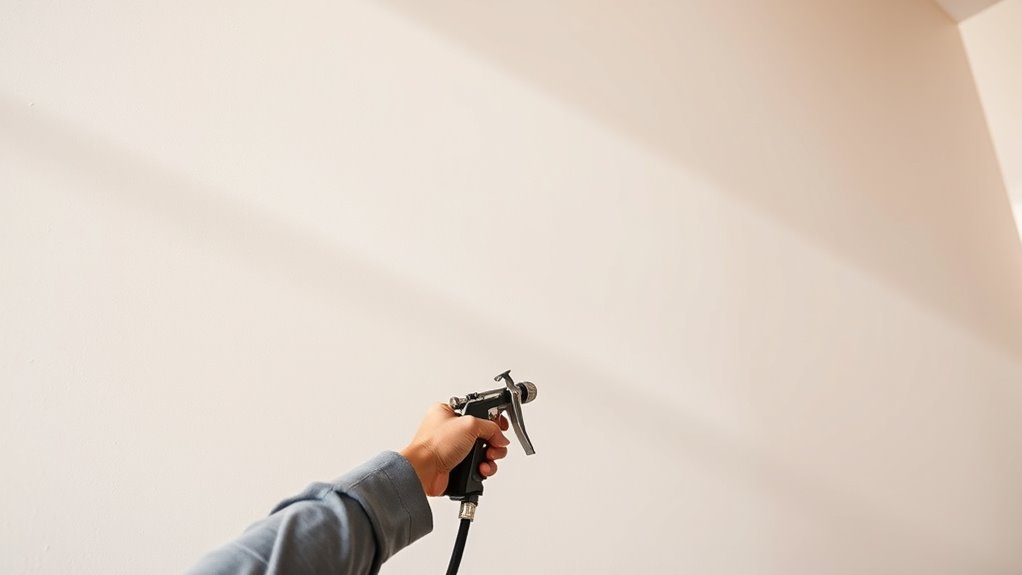
Maintaining a steady speed and consistent distance from the wall is essential for achieving a smooth, even paint coat. This prevents lap marks and ensures uniform coverage. To do this effectively:
- Keep your spray gun at a fixed distance, typically 10-12 inches from the wall.
- Move your arm steadily, avoiding accelerations or decelerations that cause uneven spray, and monitor your technique regularly for consistency.
- Use proper brush techniques when blending edges or touching up, maintaining consistent pressure.
- Ensure your paint mixing is thorough, so the coating flows smoothly without drips or clumps.
- Utilizing proper spray tips and adjusting your pressure settings can also greatly improve the quality of your finish. Additionally, practicing your technique regularly helps develop a more consistent spray pattern and reduces the likelihood of marks. Being aware of your equipment calibration is crucial to maintain optimal spray consistency throughout the project.
Consistent speed helps control paint thickness, while maintaining the right distance prevents overspray. Focus on smooth, overlapping passes, and you’ll avoid marks and achieve a professional finish.
Work in Overlapping Passes
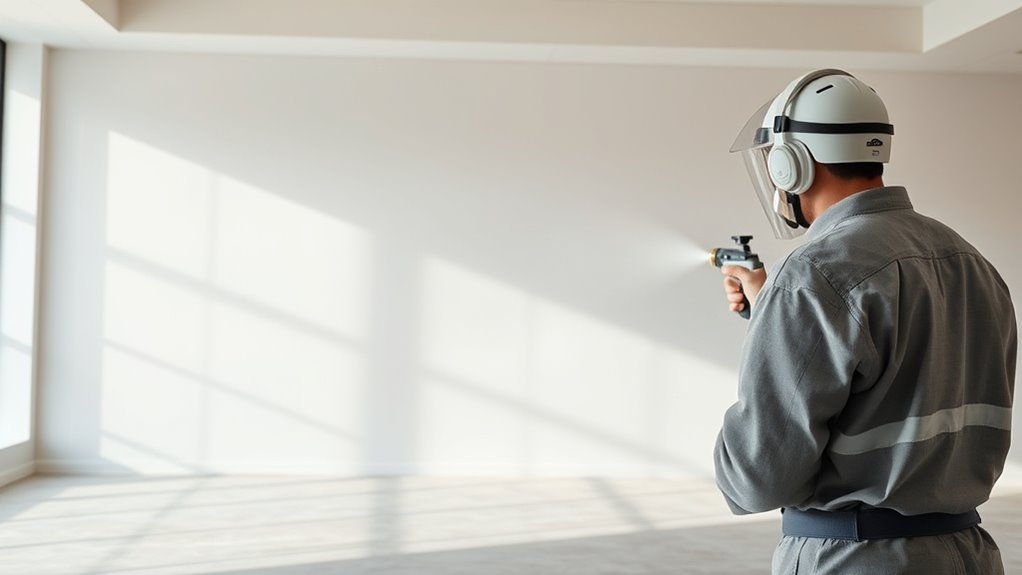
When working in overlapping passes, make sure to maintain a consistent amount of overlap to prevent lap marks. Use slightly wet edges with each pass to blend the paint smoothly. This technique helps create a uniform finish across large surfaces. Additionally, practicing dynamic communication exercises can improve coordination and understanding during your painting process, ensuring smoother application and fewer imperfections.
Maintain Consistent Overlap
To achieve a smooth, even finish, you need to keep your spray pattern consistent by overlapping each pass slightly. This guarantees even coverage and prevents lap marks. To do this effectively:
- Maintain a steady speed and distance from the wall.
- Keep your spray gun at a consistent angle and pressure.
- Use brush techniques for edges to blend overlaps seamlessly.
- Check paint consistency regularly to avoid drips or uneven flow.
Use Slightly Wet Edges
Using slightly wet edges is key to achieving a seamless wall finish. To do this, focus on your brush techniques to maintain consistent edge control. Work in overlapping passes, but don’t let the paint dry out at the edges before applying the next stroke. Keep your brush slightly moist and steady as you extend from one section to the next. This prevents visible lines or lap marks. Proper edge control ensures smooth transitions, so avoid pressing too hard or lifting too quickly. Maintain a uniform amount of paint on your brush around the edges, and work steadily along the wall. With practice, you’ll develop a feel for when your edges are just wet enough to blend seamlessly, resulting in a professional, flawless finish.
Use a Wet Edge to Prevent Dry Lines
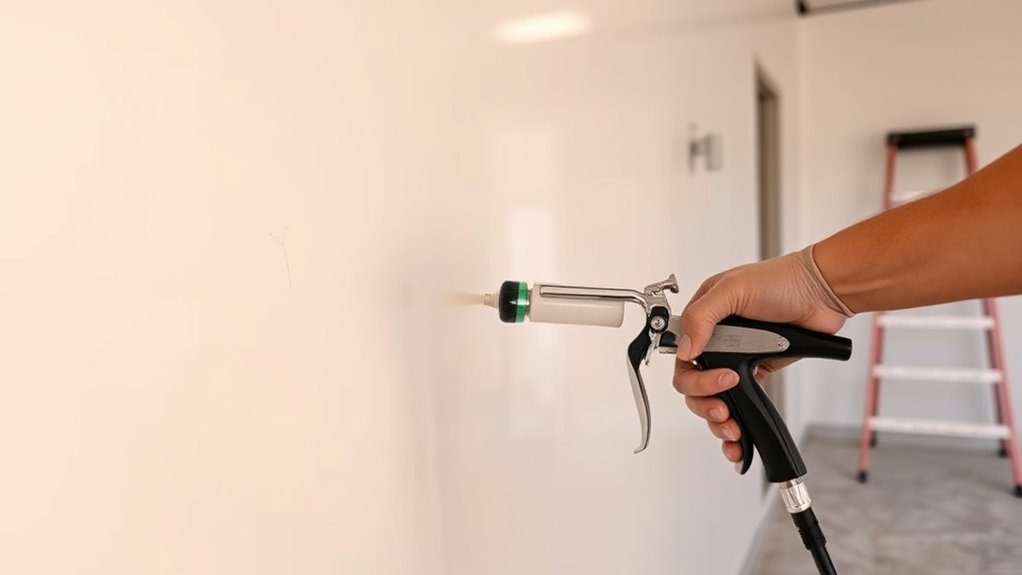
Maintaining a wet edge is essential for a smooth, uniform paint finish on large walls. It helps you avoid dry lines and ensures seamless color blending. To do this effectively:
- Keep your spray moving steadily to prevent the edge from drying out.
- Use edge feathering techniques to blend new paint into the existing wet edge smoothly.
- Work in manageable sections, overlapping slightly to maintain a continuous wet edge.
- Regularly check your progress, re-wetting areas as needed to avoid dry spots.
Adjust Spray Pattern and Pressure
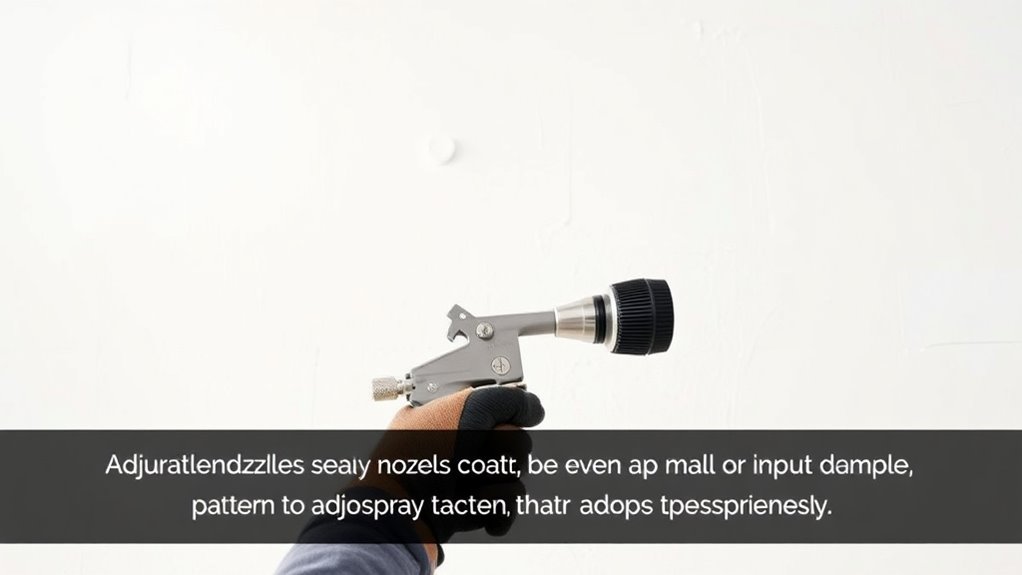
Adjusting your spray pattern and pressure is essential for achieving an even coat without drips or overspray. Properly setting your spray pattern guarantees you cover the wall uniformly, while adjusting paint pressure controls the flow and prevents runs. Use a wider spray pattern for large, flat surfaces to avoid uneven application. Lower paint pressure helps reduce overspray and drips, especially on smooth walls. Conversely, higher pressure can increase coverage but risks creating splatters. Fine-tune both settings based on your paint type and wall texture. Here’s a quick reference:
| Spray Pattern | Paint Pressure |
|---|---|
| Wide | Low |
| Narrow | High |
| Uniform | Moderate |
| Variable | Adjustable |
| Consistent | Consistent |
Proper adjustments ensure a smooth, professional finish.
Practice on a Test Surface First
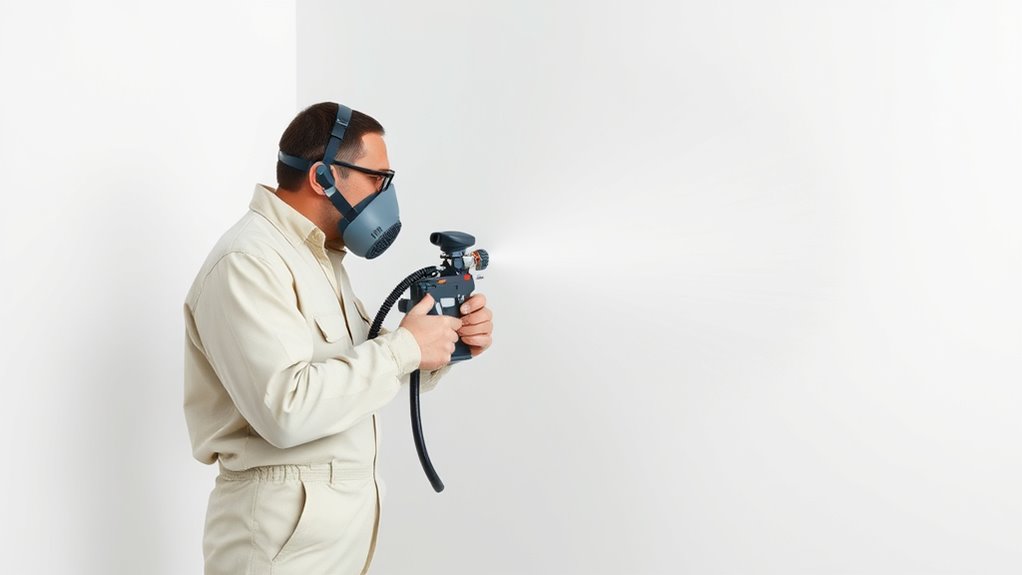
Before tackling your large wall, it’s crucial to practice on a test surface first. This helps you fine-tune your spray pattern and adjust for proper paint viscosity. Here’s what to focus on:
- Test different spray patterns to find one that covers evenly without drips or runs.
- Adjust your spray pressure to control the paint atomization and avoid overspray.
- Vary paint viscosity by thinning or thickening to achieve a smooth, consistent flow.
- Practice maintaining a steady distance and speed for even coverage.
Work in Manageable Sections
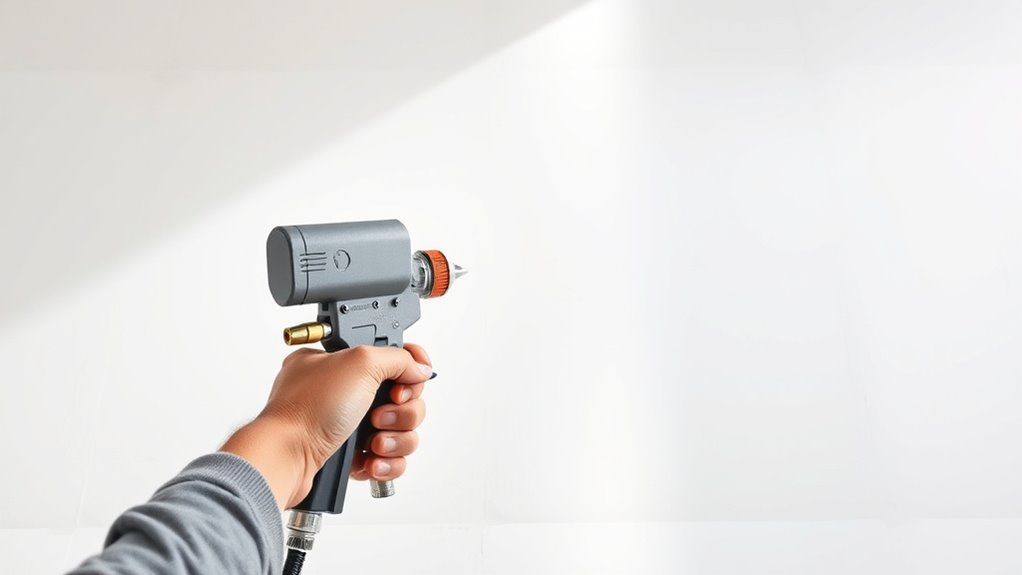
To achieve a smooth finish and avoid lap marks, break your large wall into manageable sections. Proper section planning helps you stay organized and guarantees even coverage. Divide the wall into areas roughly the size of your spraying arm’s reach, so you can complete each section before the paint dries. Set up your workspace to maximize efficiency—clear obstacles, position your ladder or scaffolding securely, and organize your tools nearby. Working in sections allows you to focus on one area at a time, reducing the risk of overlapping or uneven coats. This approach also helps maintain a consistent spraying technique, which is vital for a flawless finish. Remember, careful planning and workspace setup are key to tackling large surfaces effectively.
Inspect and Touch Up for a Flawless Finish
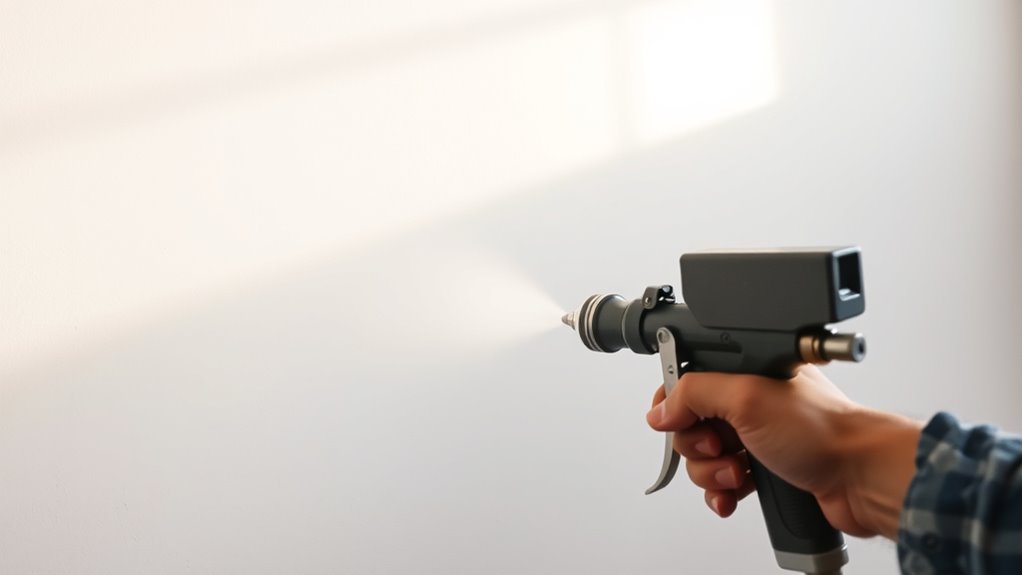
Once you’ve finished spraying, take time to carefully inspect your work for any flaws or uneven spots. Use an inspection checklist to identify areas needing attention. Focus on these key points:
- Check for lap marks, drips, or missed spots under different lighting conditions.
- Use a bright light at an angle to reveal imperfections.
- For touch-ups, apply paint with a small brush, blending edges smoothly.
- Follow specific touch-up techniques, such as feathering or stippling, to seamlessly blend repairs.
Frequently Asked Questions
What Types of Paint Are Best for Large Wall Projects?
When choosing paint for large wall projects, you want a finish that offers smooth coverage and durability. Satin or eggshell finishes are ideal because they hide imperfections and are easy to clean. Focus on color selection that matches your space’s lighting and mood. Opt for high-quality paints to guarantee even application, reducing lap marks. Ultimately, selecting the right paint finish and color helps you achieve a professional, flawless look on your large walls.
How Long Should I Wait Between Coats?
Did you know that proper drying time varies with paint thickness and humidity? You should wait at least 2-4 hours between coats, but thicker paint or high humidity can extend drying time. Rushing this step risks lap marks and uneven finishes. To guarantee smooth results, check that the previous coat is fully dry and free of tackiness before applying the next. Patience here really pays off.
Can Weather Conditions Affect Spray Painting Results?
Weather conditions definitely impact spray painting results. High humidity or rain can cause moisture interference, leading to a compromised paint film that might peel or bubble. Wind can also cause overspray and uneven coverage. To get the best finish, you should spray when the weather is dry, with low humidity and moderate temperatures. This helps make certain your paint film cures properly and prevents issues caused by moisture interference.
How Do I Prevent Drips and Runs During Spraying?
To prevent drips and runs when spraying, start with proper spray equipment maintenance, ensuring no blockages and correct nozzle settings. Use smooth, even brush techniques to control the application and avoid over-application. Keep a consistent distance from the wall, and don’t rush. Regularly check your spray pattern and adjust as needed. This helps you achieve a smooth finish and minimizes the risk of drips or runs during your painting project.
What Safety Gear Is Recommended for Spray Painting?
Imagine the risks lurking behind a simple spray session—you need protection. You should always wear a protective mask to prevent inhaling fumes and safety goggles to shield your eyes from splatters. While the job demands precision, safety gear guarantees you’re protected from potential hazards. Don’t skip these essentials; your health and vision are worth it. Stay safe, stay protected, and keep your focus on a flawless finish.
Conclusion
By preparing your surface and equipment, choosing the right spray technique, maintaining consistent speed and distance, working in overlapping passes, using a wet edge, adjusting spray pattern and pressure, practicing beforehand, working in manageable sections, and inspecting your work, you set yourself up for success. These steps guarantee smooth application, even coverage, and a flawless finish. When you stay attentive, stay consistent, and stay patient, you’ll avoid lap marks and achieve professional-looking walls every time.
